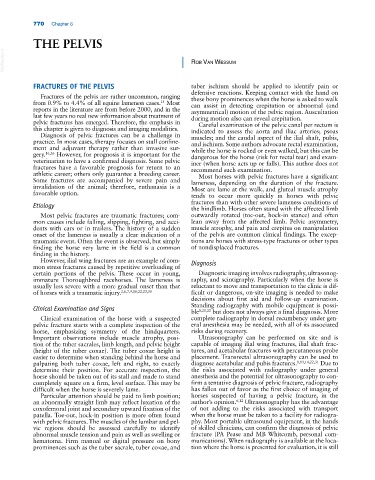Page 804 - Adams and Stashak's Lameness in Horses, 7th Edition
P. 804
770 Chapter 6
THE PELVIS
VetBooks.ir Rob Van Wessum
FRACTURES OF THE PELVIS tuber ischium should be applied to identify pain or
defensive reactions. Keeping contact with the hand on
Fractures of the pelvis are rather uncommon, ranging these bony prominences when the horse is asked to walk
15
from 0.9% to 4.4% of all equine lameness cases. Most can assist in detecting crepitation or abnormal (and
reports in the literature are from before 2000, and in the asymmetrical) motion of the pelvic region. Auscultation
last few years no real new information about treatment of during motion also can reveal crepitation.
pelvic fractures has emerged. Therefore, the emphasis in Careful examination of the pelvic canal per rectum is
this chapter is given to diagnosis and imaging modalities. indicated to assess the aorta and iliac arteries; psoas
Diagnosis of pelvic fractures can be a challenge in muscles; and the caudal aspect of the ilial shaft, pubis,
practice. In most cases, therapy focuses on stall confine- and ischium. Some authors advocate rectal examination,
ment and adjuvant therapy rather than invasive sur- while the horse is rocked or even walked, but this can be
gery. 16,26 However, for prognosis it is important for the dangerous for the horse (risk for rectal tear) and exam-
veterinarian to have a confirmed diagnosis. Some pelvic iner (when horse acts up or falls). This author does not
fractures have a favorable prognosis for return to an recommend such examination.
athletic career; others only guarantee a breeding career. Most horses with pelvic fractures have a significant
Some fractures are accompanied by severe pain and lameness, depending on the duration of the fracture.
invalidation of the animal; therefore, euthanasia is a Most are lame at the walk, and gluteal muscle atrophy
favorable option. tends to occur more quickly in horses with pelvic
Etiology fractures than with other severe lameness conditions of
the hindlimb. Horses often stand with the affected limb
Most pelvic fractures are traumatic fractures; com- outwardly rotated (toe‐out, hock‐in stance) and often
mon causes include falling, slipping, fighting, and acci- lean away from the affected limb. Pelvic asymmetry,
dents with cars or in trailers. The history of a sudden muscle atrophy, and pain and crepitus on manipulation
onset of the lameness is usually a clear indication of a of the pelvis are common clinical findings. The excep-
traumatic event. Often the event is observed, but simply tions are horses with stress‐type fractures or other types
finding the horse very lame in the field is a common of nondisplaced fractures.
finding in the history.
However, ilial wing fractures are an example of com- Diagnosis
mon stress fractures caused by repetitive overloading of
certain portions of the pelvis. These occur in young, Diagnostic imaging involves radiography, ultrasonog-
immature Thoroughbred racehorses. The lameness is raphy, and scintigraphy. Particularly when the horse is
usually less severe with a more gradual onset than that reluctant to move and transportation to the clinic is dif-
of horses with a traumatic injury. 2,6,7,9,18,22,23,30 ficult or dangerous, on‐site imaging is needed to make
decisions about first aid and follow‐up examination.
Clinical Examination and Signs Standing radiography with mobile equipment is possi-
but does not always give a final diagnosis. More
8,20,22
ble
Clinical examination of the horse with a suspected complete radiography in dorsal recumbency under gen-
pelvic fracture starts with a complete inspection of the eral anesthesia may be needed, with all of its associated
horse, emphasizing symmetry of the hindquarters. risks during recovery.
Important observations include muscle atrophy, posi- Ultrasonography can be performed on site and is
tion of the tuber sacrales, limb length, and pelvic height capable of imaging ilial wing fractures, ilial shaft frac-
(height of the tuber coxae). The tuber coxae height is tures, and acetabular fractures with percutaneous probe
easier to determine when standing behind the horse and placement. Transrectal ultrasonography can be used to
palpating both tuber coxae, left and right, to exactly diagnose acetabular and pubis fractures. 1,13,14,22,31 Due to
determine their position. For accurate inspection, the the risks associated with radiography under general
horse should be taken out of its stall and made to stand anesthesia and the potential for ultrasonography to con-
completely square on a firm, level surface. This may be firm a tentative diagnosis of pelvic fracture, radiography
difficult when the horse is severely lame. has fallen out of favor as the first choice of imaging of
Particular attention should be paid to limb position; horses suspected of having a pelvic fracture, in the
an abnormally straight limb may reflect luxation of the author’s opinion. 6,12 Ultrasonography has the advantage
coxofemoral joint and secondary upward fixation of the of not adding to the risks associated with transport
patella. Toe‐out, hock‐in position is more often found when the horse must be taken to a facility for radiogra-
with pelvic fractures. The muscles of the lumbar and pel- phy. Most portable ultrasound equipment, in the hands
vic regions should be assessed carefully to identify of skilled clinicians, can confirm the diagnosis of pelvic
abnormal muscle tension and pain as well as swelling or fracture (PA Pease and MB Whitcomb, personal com-
hematoma. Firm manual or digital pressure on bony munications). When radiography is available at the loca-
prominences such as the tuber sacrale, tuber coxae, and tion where the horse is presented for evaluation, it is still

